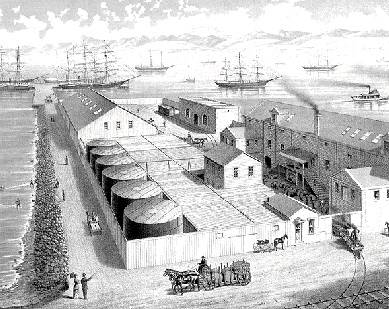The Largest Whaling Port on the West Coast, 1880s: Difference between revisions
(categories and embellished explanation) |
(transit tour stop and PC) |
||
| Line 1: | Line 1: | ||
'''<font face = Papyrus> <font color = maroon> <font size = 4>Historical Essay</font></font> </font>''' | |||
''by Chris Carlsson'' | |||
[[Image:pothill$arctic-oil-works-drawing.jpg]] | [[Image:pothill$arctic-oil-works-drawing.jpg]] | ||
| Line 8: | Line 12: | ||
''Images: Bancroft Library, Berkeley, CA'' | ''Images: Bancroft Library, Berkeley, CA'' | ||
[[Image:Transit-tour-button.jpg]] [[2nd St. Cut|-->continue Transit History Tour]] | |||
[[Shipyards_in_Decay--1996 |Prev. Document]] [[Potrero Hill Rec Center |Next Document]] | [[Shipyards_in_Decay--1996 |Prev. Document]] [[Potrero Hill Rec Center |Next Document]] | ||
[[category:Potrero Hill]] [[category:species]] [[category:Ecology]] [[category:1880s]] [[category:1890s]] | [[category:Potrero Hill]] [[category:species]] [[category:Ecology]] [[category:1880s]] [[category:1890s]] | ||
Revision as of 20:55, 16 December 2008
Historical Essay
by Chris Carlsson
Arctic Oil Works was established at end of 23rd Street in 1883 to produce refined oils from seals, whales and elephant seals. It anchored the largest whaling port in western North America for two decades. Before petroleum oil the early industrial revolution depended on the mass slaughter of the biggest mammals on the planet to supply lubricants and luminating fluids.
File:Pothill$baleen-harvest-1890.jpg
In 1890, baleen from the jaws of whales dries in the Arctic Oil Works yard. After drying it was cut into stays for corsets, collars and umbrellas, as well as for buggy whips.
Images: Bancroft Library, Berkeley, CA
File:Transit-tour-button.jpg -->continue Transit History Tour

